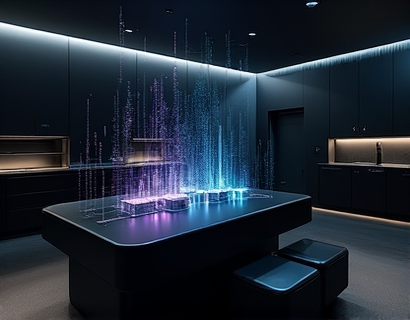Unlock Real-Time Engagement: Harnessing AI Avatar Technology for Dynamic Live Communication
The digital landscape is rapidly evolving, demanding innovative solutions to enhance live interactions and virtual events. One of the most exciting advancements in this domain is the integration of AI avatar technology. This cutting-edge solution is transforming the way businesses and content creators engage with their audiences, offering a new dimension of interactive and memorable communication. By leveraging lifelike avatars that interact in real-time, organizations can captivate their audiences like never before, setting a new standard for digital engagement.
AI avatar technology combines the realms of design and advanced artificial intelligence to create dynamic, lifelike characters that can communicate seamlessly in live settings. These avatars are not just static images or pre-recorded videos; they are intelligent entities capable of responding to audience inputs, adapting to different scenarios, and delivering personalized messages. This level of interactivity not only enhances the viewer's experience but also significantly increases engagement rates.
The applications of AI avatar technology are vast and varied. For businesses, these avatars can serve as virtual representatives at conferences, trade shows, and product launches. They can provide product demonstrations, answer customer queries, and even conduct interviews, all in real-time. This not only saves costs associated with physical presence but also allows for a broader reach, as these avatars can be accessed by a global audience.
Content creators, on the other hand, can use AI avatars to bring their stories to life in unique and engaging ways. Whether it's creating characters for animated series, enhancing live streams, or developing interactive educational content, the possibilities are endless. The ability to create and control lifelike avatars opens up new avenues for creativity and storytelling, making content more immersive and impactful.
One of the key advantages of AI avatar technology is its real-time capabilities. Unlike pre-recorded content, AI avatars can interact with the audience in real-time, responding to questions, comments, and even emotional cues. This immediacy fosters a sense of presence and connection, making the audience feel more involved and engaged. For instance, during a live Q&A session, an AI avatar can maintain eye contact, nod in agreement, and even express empathy, all of which contribute to a more natural and engaging conversation.
The technology behind AI avatars is rooted in advanced machine learning algorithms and computer vision. These avatars are trained on vast datasets to recognize and mimic human behaviors, expressions, and speech patterns. This training enables them to perform complex tasks such as facial recognition, lip-syncing, and gesture recognition, all in real-time. The result is an avatar that not only looks lifelike but also behaves in a manner that is convincing and relatable.
Another significant benefit of AI avatar technology is its scalability. Businesses can deploy these avatars across multiple platforms and devices, from large screens at events to smaller screens on mobile devices. This flexibility ensures that the audience can engage with the avatar regardless of their location or the device they are using. Moreover, the avatars can be customized to fit different brand identities and messaging strategies, providing a consistent and cohesive experience across various touchpoints.
In the context of virtual events, AI avatars can play a crucial role in overcoming the limitations of traditional online gatherings. They can facilitate networking sessions by enabling avatar-to-avatar interactions, creating virtual breakout rooms where participants can engage in smaller group discussions. This not only enhances the social aspect of virtual events but also encourages more active participation from attendees.
For educational institutions, AI avatars can revolutionize the way lectures and tutorials are delivered. Imagine a virtual professor who can adapt the pace of the lesson based on student feedback, answer questions in real-time, and even provide personalized feedback. This level of interactivity can significantly improve learning outcomes and student engagement, making education more accessible and effective.
The integration of AI avatar technology also opens up new opportunities for accessibility. For individuals with disabilities, avatars can serve as assistive tools, providing real-time translation, text-to-speech, and other accommodations. This ensures that everyone has equal access to information and can participate fully in digital interactions.
From a technical standpoint, implementing AI avatar technology involves several key components. First, high-fidelity 3D models are created to give the avatar its visual appearance. These models are then brought to life using advanced animation techniques and AI algorithms that control the avatar's movements and expressions. Natural Language Processing (NLP) is another critical component, enabling the avatar to understand and generate human-like speech. Additionally, real-time tracking and rendering technologies ensure that the avatar's interactions are smooth and lag-free, even in complex environments.
To achieve these capabilities, a robust infrastructure is necessary. This includes powerful servers to handle the computational demands of real-time rendering and processing, as well as efficient data networks to ensure low latency and high reliability. Cloud-based solutions are particularly advantageous in this regard, as they provide scalable resources that can be adjusted based on the specific needs of each event or application.
Despite its many benefits, AI avatar technology is not without challenges. One of the primary concerns is the initial cost of implementation, which can be significant due to the need for high-quality hardware and software. However, the long-term benefits, such as reduced travel costs and increased engagement, often outweigh these initial investments. Additionally, there is a learning curve associated with using this technology, requiring training for both the creators and the users of the avatars.
Another challenge is ensuring the avatars' authenticity and avoiding the uncanny valley effect, where overly realistic avatars can appear unsettling to viewers. This requires careful design and fine-tuning to strike the right balance between realism and stylization. Continuous research and development in this area are essential to overcome these hurdles and further enhance the user experience.
Looking to the future, the potential applications of AI avatar technology are vast. As the technology matures, we can expect to see even more sophisticated avatars with advanced emotional intelligence and the ability to learn from interactions. This could lead to avatars that not only communicate effectively but also build relationships and trust with their audience over time.
In conclusion, AI avatar technology represents a significant leap forward in digital engagement. By providing lifelike, real-time interactions, it transforms the way businesses and content creators connect with their audiences. Whether used for live events, educational content, or interactive storytelling, these avatars offer a powerful tool to enhance communication and create memorable experiences. As the technology continues to evolve, the possibilities for innovation and impact are truly limitless.













